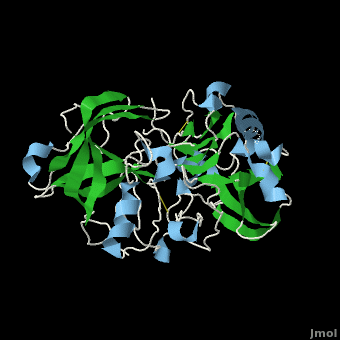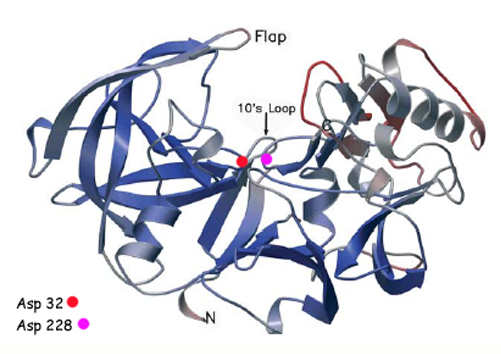Beta secretase
From Proteopedia
|
, also known as BACE (β-site of Amyloid precursor protein Cleaving Enzyme) and Memapsin 2, is an aspartyl protease found in humans. β-Secretase plays an important role in the development of Alzheimer's disease. This has made β-secretase a therapeutic target for pharmacological intervention.
Contents |
Structure of Beta Secretase
β-Secretase is a transmembrane protein, with its active site existing in the extracellular domain of the protein. Due to its nature as an aspartyl protease, β-secretase's active site is made up of . The R groups of both aspartates coordinate a single water molecule between the two of them, allowing for a nucleophilic attack to occur on the carbonyls.
There are two other important features to β-secretase. One is the . The flap is made up of residues 67 through 77. While the active site remains inactive, the flap stays in its open conformation. However, the flap is stabilized while closed over its substrate or some other inhibitor.
The other important feature is the . The 10s loop is located in the S3 pocket of β-secretase, right between two β strands. When the 10s loop takes an open conformation, it allows for greater binding between the substrate and the S3 pocket. The 10s loop also contains within it a that can hydrogen bond with the substrate, allowing for further stabilization of the 10s loop, as well as the overall β-secretase-substrate interaction.
The three parts come together to form a sort of binding pocket for β-secretase's substrates or inhibitors. Binding to the active site activates the flap to close and initiates binding by the 10s loop, all to help stabilize the structure.
Alzheimer's Disease
Alzheimer's disease is a neurodegenerative disease, and one of the most common forms of dementia. Early symptoms include things like loss of short-term memory and impairment of some physical movements. As the disease progresses, memory impairment worsens, muscle deteriorates, and the patient eventually dies. Patients of the later stages of Alzheimer's usually need to be taken care of as they are not able to take care of themselves at that point.
Alzheimer's disease occurs by the build up plaques that lead to the death of neurons. The plaques themselves are formed from the buildup of amyloid beta (Aβ). Aβ is produced by the cleavage of amyloid precursor protein (APP), an integral membrane protein found in the synapses of neurons. The cleavage of APP itself can go down one of two pathways.
Inhibition of Beta Secretase
References
Proteopedia Page Contributors and Editors (what is this?)
Michal Harel, Alexander Berchansky, Daniel Santos, Jaime Prilusky, Joel L. Sussman, David Canner


